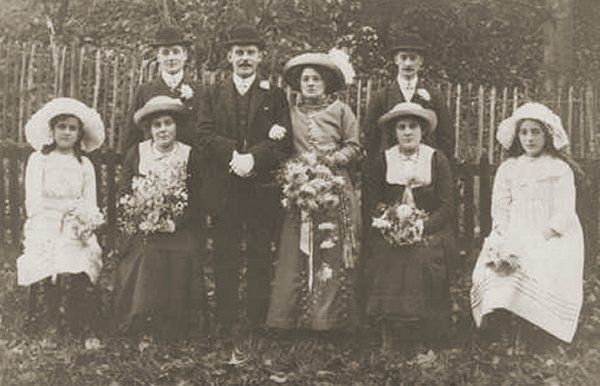yeovil at War
Stanley Glover
Killed in action during the Capture of La Boisselle
Stanley Glover was born in Yeovil in 1884, the son of railway locomotive stoker John Glover (1862-1942) and Charlotte née Hambridge (1863-1932). John and Charlotte were married in the Baptist Chapel in South Street on 10 September 1883. Stanley was the eldest of the nine children (one died in childhood) of John and Charlotte, mostly born in Yeovil; Stanley, Ethel Lily, known as Lily (1885-1962), William John (1887-1922), Maud (1889-1965), Edwin Frank, known as Frank (1891-1971), Beatrice Amelia (b1895, Exeter), Elizabeth (b1897, Chard) and Hilda May (b1901, Salisbury)
In the 1891 census John and Charlotte were living at 7 Smith's Terrace, Newtown, with Stanley, Lily, William, Maud and Frank. John gave his occupation as a locomotive stoker and all the children were listed as scholars. By 1895 the family had moved to Exeter, later moving to Chard and finally to Salisbury, Wiltshire. In 1901 the family were listed at Fisherton Anger, Salisbury and by this time John was working as an engine driver and Stanley was a greaser, both working for the London and South West Railway Company.
 Stanley
enlisted in the
army at
Salisbury around
January 1904,
becoming a
Private in the
Wiltshire
Regiment (Duke
of Edinburgh's).
It is not known
which battalion
Stanley served
in - the 1st
Battalion was in
the usual
routine of
postings in
Britain, Ireland
and India during
this period.
From 1905 the
1st Battalion
was in India,
until 1909 when
it moved to
South Africa for
five years,
returning to
England in 1913.
The 2nd
Battalion
returned to
England from
South Africa in
1903, spending
time there and
in Ireland
before moving to
Gibraltar in
1913.
Stanley
enlisted in the
army at
Salisbury around
January 1904,
becoming a
Private in the
Wiltshire
Regiment (Duke
of Edinburgh's).
It is not known
which battalion
Stanley served
in - the 1st
Battalion was in
the usual
routine of
postings in
Britain, Ireland
and India during
this period.
From 1905 the
1st Battalion
was in India,
until 1909 when
it moved to
South Africa for
five years,
returning to
England in 1913.
The 2nd
Battalion
returned to
England from
South Africa in
1903, spending
time there and
in Ireland
before moving to
Gibraltar in
1913.
At the time of the 1911 census Stanley was at home with his family in Salisbury where he gave his occupation simply as a soldier. His father John, by this time, was working as an engine driver.
By 1913 Stanley had left the army and was working as a postman in Salisbury although, of course, he would have been a National Reservist. On 22 November 1913 he married Florence Mary Jerred (1885-1937) at Salisbury. They were to have a son, Frank Stanley James (1914-1974).
As a Reservist, Stanley would have been called back to the Colours, possibly at the outbreak of war in August 1914, retaining his rank of Sergeant. The 6th Battalion embarked for France in July 1915 as part of the 19th Division. They initially were introduced to trench warfare in the Laventie and Festubert area with their first attack taking place at Loos in September. At the start of 1916 the 6th Battalion were in the Neuve Chapelle area where they were engaged in trench warfare until April. After a period of strenuous training the battalion moved to Albert, on the River Somme in preparation for the forthcoming offensive. A week after the start of the Battle of the Somme they took part in the capture of La Boisselle.
The Capture of La Boisselle (1–6 July 1916) was a British local operation during the Battle of Albert, the name given by the British to the first two weeks of the Battle of the Somme. On 1 July 1916, the first day on the Somme, La Boisselle was attacked by the 34th Division as part of the III Corps but the bombardment had not damaged the German deep-mined dug-outs and a German listening post overheard a British telephone conversation the day before, which gave away the attack. The III Corps divisions lost more than 11,000 casualties and failed to capture La Boisselle. The advance of the 103rd Brigade was over ground with a fold, which meant that the disastrous attack by the preceding brigades could not be seen as the brigade advanced to be engaged by artillery and machine-gun fire, which inflicted 70 percent casualties, before the troops had reached the British front line. The 19th (Western) Division was rushed forward from reserve, in case of a German counter-attack on Albert. Sadly Sergeant Stanley Gl;over was killed in action on the second day of the battle, 2 July 1916. He was 32 years old.
The 19th Division continued the attack and captured most of the village by 4 July, completing the operation by 6 July.
Stanley Glover's name is inscribed on the Thiepval Monument. His name was added to the War Memorial in the Borough in 2018.
gallery

The early home of Stanley Glover was Smith's Terrace, the 'front' of the terrace, seen from North Terrace. Photographed in 2014.

Sergeant Stanley Glover poses in uniform.

Stanley and Florence's wedding photograph, 22 November 1913.

The Commonwealth War Graves Commission certificate in memory of Stanley Glover.